|

by Rob Cooper
1 July 2012
from
DailyMail Website
Scientists 'will say they are
99.99% certain'
the particle has been found.
Leading physicists have been invited to event,
sparking speculation
that
Higgs boson particle has been found.
'God Particle' gives particles
that make up atoms their mass.
Fermi Lab in Chicago also 'closing in'
on proof of Higgs boson.
Scientists at
CERN will announce that
the elusive Higgs boson 'God Particle' has been found at a press
conference next week, it is believed.
Five leading theoretical physicists have been invited to the event
on Wednesday - sparking speculation that the particle has been
discovered.
Scientists at
the Large Hadron Collider are expected to
say they are 99.99 per cent certain it has been found - which is
known as 'four sigma' level.
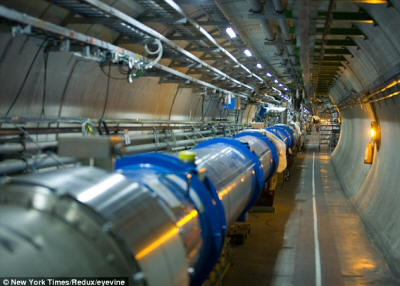
Big enough to matter:
The collider, formed
of superconducting magnets,
stretches around
17miles or 27km - and is sensitive to the moon's gravity
The
particle accelerator - It is within these tubes that physicists are
hunting for the 'God' particle
Physicists
first predicted
...that the Higgs Boson subatomic particle exists
48 years ago
Thank God this wasn't our sun! Hubble spots planet shedding
atmosphere following solar flare outburst
Peter Higgs, the Edinburgh University emeritus professor of
physics that the particle is named after, is among those who have
been called to the press conference in Switzerland.
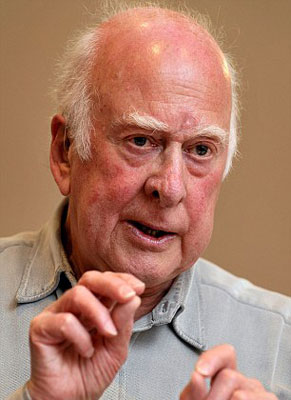
Peter Higgs, the
professor the particle is named after,
has been asked to
attend the press conference at Cern
The management at Cern want the two
teams of scientists to reach the 'five sigma' level of certainty
with their results - so they are 99.99995 per cent sure - such is
the significance of the results.
Tom Kibble, 79, the emeritus professor of physics at Imperial
College London, has also been invited but is unable to attend.
He told the Sunday Times:
'My guess is that is must be a
pretty positive result for them to be asking us out there.'
The Higgs boson is regarded as the key
to understanding the universe.
Physicists say its job is to give the
particles that make up atoms their mass.
Without this mass, these particles would zip though the cosmos at
the speed of light, unable to bind together to form the atoms that
make up everything in the universe, from planets to people.
The collider, housed in an 18-mile tunnel buried deep underground
near the French-Swiss border, smashes beams of protons - sub-atomic
particles - together at close to the speed of light, recreating the
conditions that existed a fraction of a second after the Big Bang.
If the physicists’ theory is correct, a few Higgs bosons should be
created in every trillion collisions, before rapidly decaying.
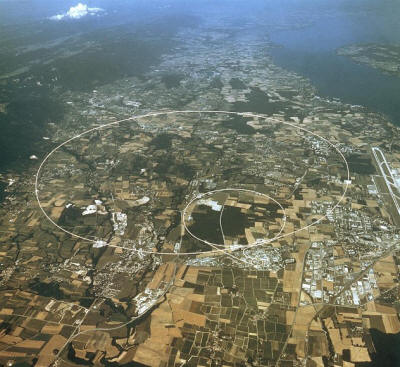
A full moon disrupts
the circle:
An aerial view of the
Swiss-French border, indicating the route of the Large Hadron
Collider
This decay would leave behind a
‘footprint’ that would show up as a bump in their graphs.
However, despite 1,600 trillion collisions being created in the
tunnel - there have been fewer than 300 potential Higgs particles.
Now it is thought that two separate teams of scientists, who run
independent experiments in secret from each other, have both
uncovered evidence of the particle.
However, the two groups,
CMS and
ATLAS, are expected to stop short
of confirming its existence.
American Accelerator
Also Finds Evidence fro Higgs Boson
Physicists at a U.S. laboratory say are
also close to proving the existence of the Higgs boson.
The announcement by the Fermi National Accelerator Lab outside
Chicago came two days before physicists at CERN are set to unveil
their own findings in the Higgs hunt.
The Fermilab scientists found hints of the Higgs in the debris from
trillions of collisions between beams of protons and anti-protons
over 10 years at the lab's now-shuttered
Tevatron accelerator.
But the evidence still fell short of the scientific threshold for
proof of the discovery of the particle, they said, in that the same
collision debris hinting at the existence of the Higgs could also
come from other subatomic particles.
'This is the best answer that is out
there at the moment,' said physicist Rob Roser of Fermilab,
which is run by the U.S. Department of Energy.
'The Tevatron
data strongly point toward the existence of the Higgs boson, but
it will take results from the experiments at the Large Hadron
Collider in Europe to establish a firm discovery.'
Physicists not connected to Fermilab
expressed cautious optimism that the long-sought particle had
finally been found.
'These intriguing hints from the
Tevatron appear to support the results from the LHC shown at
CERN in December,' said Dan Tovey, professor of particle physics
at the University of Sheffield in Britain.
'The results are particularly important because they use a
completely different and complementary way of searching for the
Higgs boson. This gives us more confidence that what we are
seeing is really evidence of new physics rather than just a
statistical fluke,' Tovey added.
Tovey said scientists will have to wait
until Wednesday for the latest results from the European scientists
before 'getting the full picture' concerning the Higgs boson.
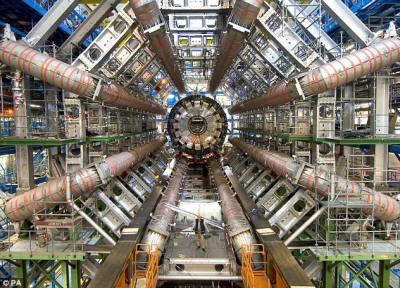
Inside: The giant
project is the most enormous piece
of scientific apparatus ever
constructed, and is buried 100m beneath the ground
Animation of an actual ATLAS proton collision
event in 2011...
"God Particle" Found?
"Historic Milestone" from Higgs Boson Hunters
by Ker Than
July 4, 2012
from
NationalGeographicNews Website
Newfound particle may be at the core of
existence.
The Higgs particle erupting from the collision of protons.
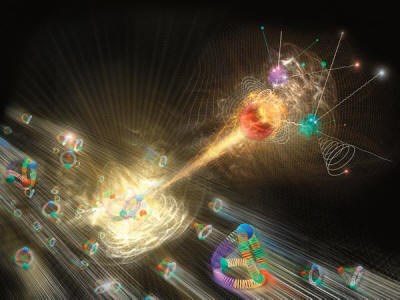
In an artist's
conception, a Higgs boson erupts from a collision of protons.
Illustration by Moonrunner Design Ltd., National Geographic
"I think we have it. You agree?"
Speaking to a packed audience Wednesday
morning in Geneva, CERN director general Rolf Heuer confirmed
that two separate teams working at
the Large Hadron Collider (LHC) are
more than 99 percent certain they've discovered
the Higgs boson, aka the God
particle - or at the least a brand-new particle exactly where
they expected the Higgs to be.
The long-sought particle may complete the standard model of physics
by explaining why objects in our universe have mass - and in so
doing, why galaxies, planets, and even humans have any right to
exist.
"We have a discovery," Heuer said at
the seminar. "We have observed a new particle consistent with a
Higgs boson."
At the meeting were four theorists who
helped develop the Higgs theory in the 1960s, including
Peter
Higgs himself, who could be seen wiping away tears as the
announcement was made.
Although preliminary, the results show a so-called five-sigma of
significance, which means that there is only a one in a million
chance that the Higgs-like signal the teams observed is a
statistical fluke.
"It's a tremendous and exciting
time," said physicist Michael Tuts, who works with
the ATLAS (A Toroidal LHC Apparatus) Experiment, one of the two Higgs-seeking
LHC projects.
The Columbia University physicist had
organized a wee-hours gathering of physicists and students in the
U.S. to watch the announcement, which took place at 9 a.m., Geneva
time.
"This is the payoff. This is what
you do it for."
The two LHC teams searching for the
Higgs - the other being
the CMS (Compact Muon Solenoid) project -
did so independently.
Neither one knew what the other would
present this morning.
"It was interesting that the
competing experiment essentially had the same result," said
physicist
Ryszard Stroynowski, an ATLAS team member based at
Southern Methodist University in Dallas. "It provides additional
confirmation."
CERN head Heuer called today's
announcement a "historic milestone" but cautioned that much work
lies ahead as physicists attempt to confirm the newfound particle's
identity and further probe its properties.
For example, though the teams are certain the new particle has the
proper mass for the predicted Higgs boson, they still need to
determine whether it behaves as the God particle is thought to
behave - and therefore what its role in the creation and maintenance
of the universe is.
"I think we can all be proud... but
it's a beginning," Heuer said.
Higgs Boson
Results Exceeded Expectations
The five-sigma results from both the ATLAS and CMS experiments
exceeded the expectations of many physicists,
including David
Evans, leader of the U.K. team that works on the LHC-based
ALICE (A Large Ion Collider
Experiment) Collaboration.
Evans had predicted Tuesday the teams would announce a four-sigma
result - just short of the rigorous standard traditionally required
for a new-particle observation to officially count as a true
discovery and not a fluke.
"It's even better than I expected,"
said Evans, of the University of Birmingham in the U.K. "I think
we can say the Higgs is here. It exists."
Evans attributed the
stronger-than-expected results to,
"a mixture of the LHC doing a
fantastic job" and "ATLAS and CMS doing a fantastic job of
improving their analysis since December," when
the two teams
announced a two-sigma observation of signs of a Higgs-like
particle.
"So even with the same data, they can get more significance."
ATLAS spokesperson Fabiola Gianotti
also had high praise for the LHC, a multibillion-dollar machine that
had suffered numerous mishaps and setbacks in its early days.
"The LHC and experiments have been
doing miracles. I think we are working beyond design," the
Italian particle physicist added.
ALICE's Evans said he was extremely
pleased by the Higgs results but admitted feeling just a bit
disappointed that the results weren't more surprising.
"Secretly I would have loved it to
be something slightly different than the standard model
predictions, because that would indicate that there's something
more out there."
On God-Particle Hunt,
It's "Easy to Fool Yourself"
Wednesday's announcement builds on results from last December, when
the ATLAS and CMS teams said their data suggested that the Higgs
boson has a mass of about 125 gigaelectron volts (GeV) - about 125
times the mass of a proton, a positively charged particle in an
atom's nucleus.
"For the first time there was a case
where we expected to [rule out] the Higgs, and we weren't able
to do so," said
Tim Barklow, an experimental physicist with the
ATLAS Experiment who's based at Stanford University's
SLAC
National Accelerator Laboratory.
A two-sigma finding translates to about
a 95 percent chance that results are not due to a statistical fluke.
While that might seem impressive, it falls short of the stringent
five-sigma level that high-energy physicists traditionally require
for an official discovery.
Five sigma means there's a less than one
in a million probability that a finding is due to chance.
"We make these rules and impose them
on ourselves because, when you are exploring on the frontier, it
is easy to fool yourself," said
Michael Peskin, a theoretical
physicist also at SLAC.
Higgs Holds It
All Together?
The Higgs boson is one of the final puzzle pieces required for a
complete understanding of the standard model of physics - the so-far
successful theory that explains how fundamental particles interact
with the elementary forces of nature.
The so-called God particle was
proposed in the 1960s by Peter Higgs
to explain why some particles, such as quarks - building blocks of
protons, among other things - and electrons have mass, while others,
such as the light-carrying photon particle, do not.
Higgs's idea was that the universe is bathed in an invisible field
similar to a magnetic field. Every particle feels this field - now
known as the Higgs field - but to varying degrees.
If a particle can move through this field with little or no
interaction, there will be no drag, and that particle will have
little or no mass. Alternatively, if a particle interacts
significantly with the Higgs field, it will have a higher mass.
The idea of the Higgs field requires the acceptance of a related
particle: the Higgs boson.
According to the standard model, if the Higgs field didn't exist,
the universe would be a very different place, said SLAC's Peskin,
who isn't involved in the LHC experiments.
"It would be very difficult to form
atoms," Peskin said. "So our orderly world, where matter is made
of atoms, and electrons form chemical bonds - we wouldn't have
that if we did not have the Higgs field."
In other words: no galaxies, no stars,
no planets, no life on Earth.
"Nature Is
Really Nasty" to Higgs Boson Seekers
Buried beneath the French-Swiss border, the Large Hadron Collider is
essentially a 17-mile-long (27-kilometer-long) oval tunnel. Inside,
counter-rotating beams of protons are boosted to nearly the speed of
light using an electric field before being magnetically steered into
collisions.
Exotic fundamental particles - some of which likely haven't existed
since the early moments after the big bang - are created in the
high-energy crashes. But the odd particles hang around for only
fractions of a second before decaying into other particles.
Theory predicts that the Higgs boson's existence is too fleeting to
be recorded by LHC instruments, but physicists think they can
confirm its creation if they can spot the particles it decays into.
The big science of the very small
Physicists have high
hopes for Europe's giant new atom smasher;
they want nothing less than to
crack the code of the physical universe.
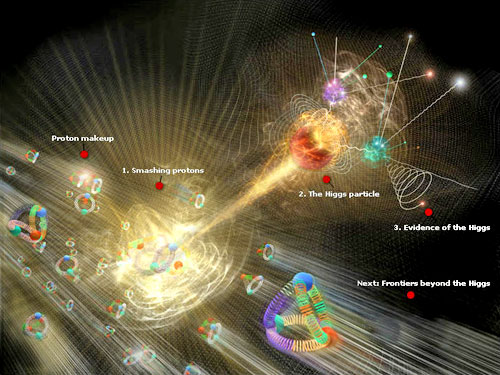
Click image
Now that the Higgs boson - or something like it - has been confirmed
to indeed have a mass of around 125 to 126 GeV, scientists have a
better idea why the God particle has avoided detection for so long.
This mass is just high enough to be out of reach of earlier,
lower-energy particle accelerators, such as the LHC's predecessor,
the Large Electron-Positron Collider, which could probe to only
about 115 GeV.
At the same time 125 GeV is not so massive that it produces decay
products so unusual that their detection would be clear proof of the
Higgs's existence.
In reality the Higgs appears to transform into relatively
commonplace decay products such as quarks, which are produced by the
millions at the LHC.
"It just so happens that nature is
really nasty to us, and the range that we've narrowed [the
Higgs] down to is the range that makes it most difficult to
find," ALICE's Evans said.
Despite the challenges, ATLAS's Gianotti
said, it's fortunate that the Higgs has the mass that it does.
"It's very nice for the
standard-model Higgs boson to be at that mass," she said.
"Because at that mass we can measure it at the LHC in a huge
number of final states. So, thanks Nature."
Going for the
Gold
While the search for the Higgs was a primary motivation for the
construction of the LHC, activity at the world's largest atom
smasher won't stop if the Higgs boson is confirmed.
For one thing, the two teams will be busy preparing the data they
presented today for submission to scientific journals for
publication.
There are also lingering questions that will require years of
follow-up work, such as what the God particle's "decay channels" are
- that is, what particles the Higgs transforms into as it sheds
energy.
The answer to that question will allow physicists to determine
whether the particle they have discovered is the one predicted from
theory or something more exotic, Columbia University's Tuts
said.
"Does it really smell and taste like
a Higgs? Is it being produced at the rate that a standard model
Higgs would predict? That's the work that's going to go on over
the course of this year at least," he added.
Something the public often forgets, too,
is that ATLAS and CMS make up only two of the LHC's four major
experiments, Evans said.
The other two - the
LHCb Collaboration
and Evan's own ALICE - are investigating other physics arcana, such
as why the universe contains so little antimatter.
"If you want to compare it to the
Olympics, finding the Higgs would be like winning just one gold
medal," Evans said.
"I'm sure most countries would like to win more than one gold
medal. And I think CERN is going to deliver a lot more gold
medals over the years."
Physicists Break Down Concept of 'God
Particle'
by Dan Vergano
July 05, 2012
from
USATODAY Website
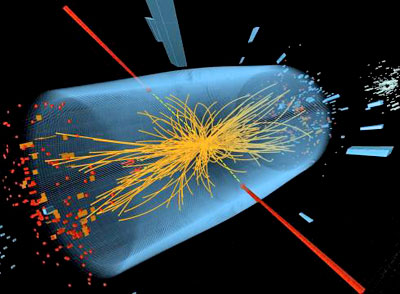
Computer depiction of
a proton collision shows a pattern consistent
with the Higgs
boson's predicted existence.
Physicists welcomed July Fourth with
intellectual fireworks, announcing "preliminary" results pointing to
the discovery of the long-sought "God particle."
Formally known as
the Higgs boson, it was detected in
experiments at the European Organization for Nuclear Research
(CERN) lab near Geneva.
For the non-scientists who wonder what a Higgs boson is, USA TODAY
distilled explanations from a number of physicists, including
Paul Padley of Rice University, part of one of the discovery
teams:
Q: So what is a Higgs boson?
A: A tiny subatomic particle that apparently weighs about 130
times as much as an atom of hydrogen, the lightest gas.
Q: What does it do?
A: Simply put, the Higgs particle interacts with other subatomic
particles that are building blocks of atoms in a way that slows
them down. It's the reason that matter in the universe has mass.
Mass gives the particles inertia, or resistance to being moved
faster.
Q: What is a simple analogy that describes this effect?
A: Compare Higgs bosons to groupies mobbing a celebrity. The
other particles are the celebrities, desperately trying to move
but slowed by autograph-seekers. Higgs bosons don't have pens,
but the attention they give to the other particles slows them,
creating inertia.
Q: Why did physicists think this likely had to exist?
A: Physicists look to particles to explain forces in the
universe. In the physicists' theories, electromagnetic and
nuclear forces don't need particles with mass to work. But the
particles do have mass, so we need an explanation for why. In
1964, Peter Higgs of Scotland's University of Edinburgh and
other physicists theorized the Higgs boson was the culprit.
Q: How did they make this discovery?
Essentially, two teams collected data in separate experiments
that smashed together millions of subatomic particles called
protons to see what pieces emerged from the smash-ups. The
particle reported on Wednesday fell to pieces in ways predicted
by Higgs and other physicists.
Q: How sure are they that this is the Higgs boson?
A: CERN chief Rolf Heuer calls it "a particle consistent with
the Higgs boson." CERN assigned about a 0.000057% statistical
chance of the particle detection being wrong.
|








